We usually think of food as a source of comfort, a daily necessity, or even a delightful treat. But what if the very items we enjoy could turn into agents of chaos? It sounds like fiction, but history is surprisingly full of instances where food and its production led to shocking and sometimes deadly catastrophes. Forget your typical natural disasters; get ready to explore a different kind of calamity, where everyday edibles took center stage in some truly unbelievable events.
10 London Beer Flood
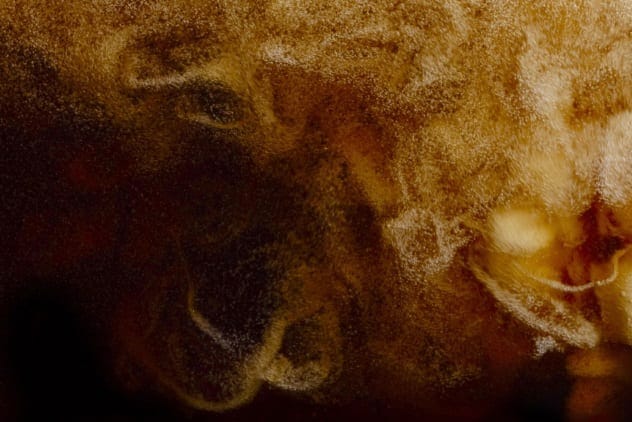
Imagine a wave of beer crashing through the streets! For ale enthusiasts, it might sound like a dream, but for the residents of a poor London district in 1814, it was a horrifying reality. On October 17, a massive vat at the Meux and Co. Brewery catastrophically failed when a metal ring snapped. This triggered a domino effect, causing nearby kegs to topple and unleash an astonishing 1.47 million liters (that’s over 388,000 gallons) of beer into the neighborhood.
This beer tsunami wasn’t a gentle stream; it surged with enough force to smash through the brewery wall, instantly killing a waiter in the adjacent tavern. The boozy river then flowed down Great Russell Street. While some adventurous locals reportedly tried to scoop up a “free pint,” the flood caused extensive damage to homes. Tragically, seven more people lost their lives, predominantly in a narrow lane behind the brewery where they were trapped by the sudden rush. The official inquiry later deemed the incident a peculiar, yet natural, disaster.
9 Boston’s Great Molasses Flood
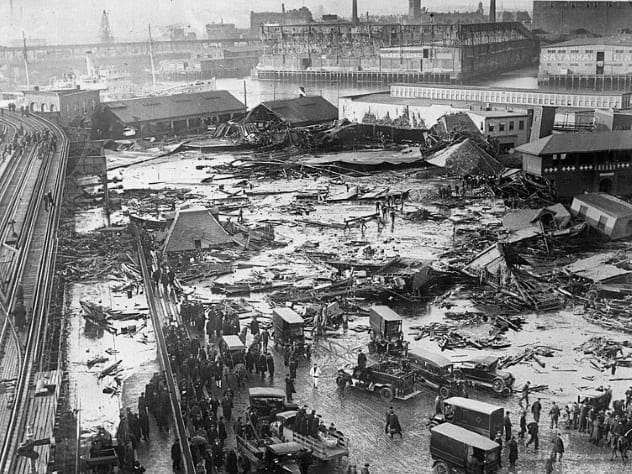
Residents of a Boston neighborhood faced an incredibly sticky and tragic end in January 1919. An unusually warm day caused an enormous tank at the Purity Distilling Company, holding 8.7 million liters (around 2.3 million gallons) of molasses, to buckle and explode. A colossal wave of thick, sugary syrup surged from the factory, sweeping away nearby buildings with its immense power.
The disaster claimed the lives of 21 people and left 150 injured. The initial blast damaged several structures, and the ensuing wave of molasses added to the destruction, carrying rubble into the harbor. Reports from the time stated the force of the explosion was so great that it damaged a section of the Boston Railway. For months afterward, the area was said to be permeated by the sickly sweet smell of molasses. Investigations pointed to a combination of a faulty storage tank and the unseasonable warmth as the causes. Today, a plaque on Commercial Street stands as a solemn reminder of this bizarre and deadly event.
8 Russian Fruit Juice Flood
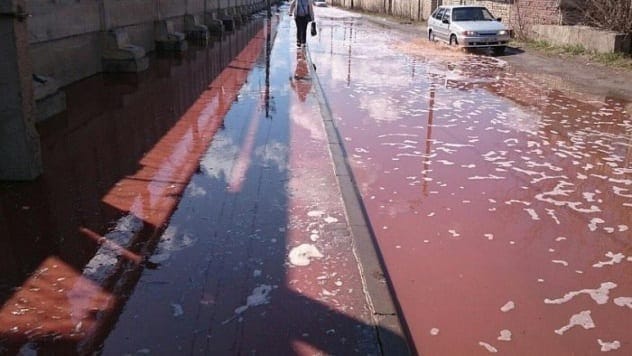
When fruit prices are low, it’s common for markets to be flooded with produce, often sold for juicing. However, in 2017, the Russian town of Lebedyan experienced a literal flood – of fruit juice! The chaos began when the roof of a local beverage manufacturing plant suddenly collapsed, injuring two workers inside.
As the roof caved in, it damaged vast stocks of packaged fruit juices stored in the warehouse. While rescuers worked to clear the debris and help the injured, tons of mixed juices escaped from the damaged containers. This sticky torrent flowed out of the factory and into the town’s streets. Attempts to contain the sugary river proved futile, and it eventually found its way into the River Don. Fortunately, this colorful disaster didn’t result in any fatalities; the trapped workers were hospitalized with only minor injuries.
7 Tapioca Tanker Disaster

In a strange maritime incident in 1972, a Swiss freighter named the Cassarate narrowly avoided disaster after unintentionally creating the world’s largest tapioca pudding within its hull. The ship was transporting a mixed cargo including lumber and grains when a fire ignited in the timber stored in the upper holds. For 25 grueling days, the crew battled the smoldering flames, dousing them with water.
However, this firefighting effort had an unforeseen consequence. The water seeped down into the lower decks where the tapioca cargo was stored. The combination of the water and the heat from the fire effectively “cooked” the tapioca. The result was a massive, expanding dessert large enough to feed a million people! This swelling mass of cooked grain threatened to burst the ship’s hull. The Cassarate made an emergency docking in Cardiff, Wales, where firefighters continued to manage the lumber blaze before facing the unique challenge of disposing of an estimated 500 truckloads of unwanted tapioca pudding.
6 Glasgow Distillery Fire
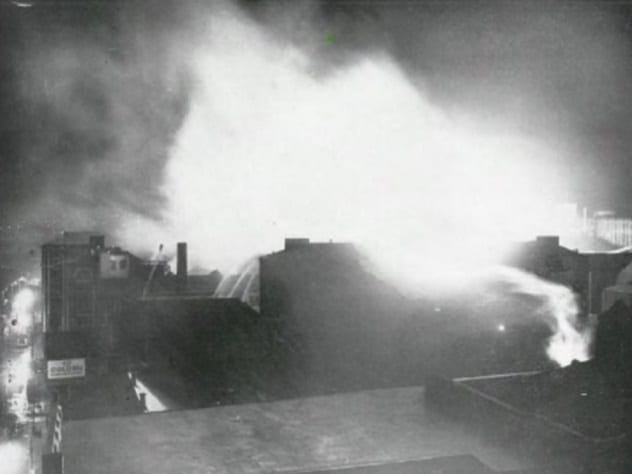
Whiskey’s flammability was once a measure of its quality, but this very characteristic led to one of modern Scotland’s worst disasters. In 1960, a fire at a Glasgow distillery caused enormous vats of pure alcohol to explode like bombs, sending debris flying across the surrounding area. The alcohol-fueled inferno raged so intensely that its blue flames were reportedly visible throughout the city.
The Arbuckle, Smith, and Co. Limited warehouse on Cheapside Street held an incredible stockpile: over 3.8 million liters (a million gallons) of whiskey and more than 117,000 liters (31,000 gallons) of rum. When fire broke out, the highly flammable spirits ignited and exploded, devastating the warehouse. The blaze also destroyed a neighboring tobacco warehouse and several other buildings. Over 400 firefighters were called to what was described as Britain’s worst peacetime fire. Tragically, as the walls of the bond store continued to collapse, 19 firefighters lost their lives while attempting to control the inferno, which took a week to fully extinguish.
5 Norwegian Goat Cheese Fire

Cheese might seem like one of the most harmless foods imaginable. However, you might want to reconsider its innocent reputation, especially when melting it on toast, as it has rather combustible properties. This was spectacularly demonstrated during a truck accident in Norway.
In 2013, a truck transporting a load of Brunost, a traditional Norwegian brown cheese, was driving through a tunnel in Tysfjord, Northern Norway. The driver noticed a fire at the back of his truck and quickly abandoned the vehicle about 300 meters (1,000 feet) inside the tunnel. The Brunost, with its high sugar and fat content, ignited fiercely, burning “almost like petrol,” according to officials. The blaze sent plumes of toxic, cheesy fumes billowing through the tunnel. Emergency services had to wait until the hazardous fumes dissipated before they could safely begin recovery operations. The tunnel remained closed for several weeks due to the significant damage caused by this bizarre and intense cheese fire.
4 Washburn A Mill Fire
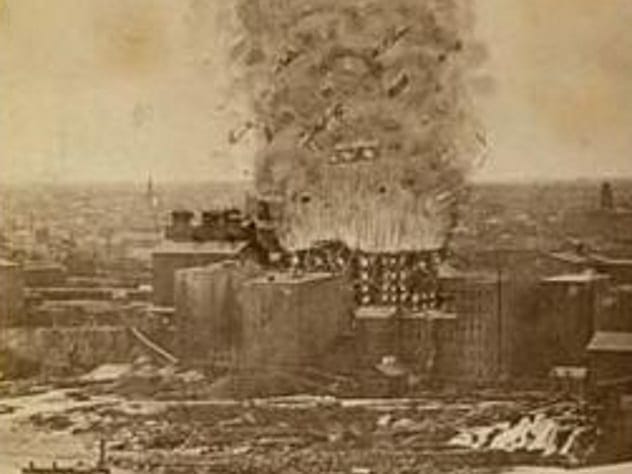
In 1878, the city of Minneapolis was violently shaken by a massive “flour bomb.” An explosion at the Washburn A flour mill, the town’s largest employer, sent shockwaves through the community and tragically killed 18 mill workers. The disaster began when a fire broke out in the basement of the seven-story mill. An eyewitness described watching the fire eerily illuminate one floor after another.
Before long, the huge stone building was reduced to a heap of rubble. The fire erupted during a shift change, giving workers no time to evacuate before the fine flour dust ignited, triggering a series of devastating blasts. It took only minutes for the explosive flour fire to obliterate the building. The force was so immense that debris rained down, destroying adjacent mills and claiming four more lives. The explosions were so powerful that residents in nearby towns initially feared an earthquake had struck. A coroner’s inquest later determined that highly combustible flour dust suspended in the air had fueled the catastrophic explosions.
3 Hawaiian Molasses Spill

While no human lives were lost in Hawaii’s encounter with runaway molasses, the incident created a significant and sticky environmental problem. Sugarcane plantations around Honolulu process their crop and send molasses to the mainland for sale.
In 2013, a disaster unfolded when a pipeline carrying molasses from processing plants to cargo ships anchored in Honolulu Harbor sprang a leak. Over 871,000 liters (approximately 230,000 gallons) of thick, dark molasses seeped into the harbor. This created an environmental emergency comparable to a major oil spill. Thousands of fish and other marine creatures began to suffocate in the viscous, oxygen-depleting mess. Fortunately, molasses has one advantage over oil in such situations: it’s water-soluble. The sticky pollutant eventually dissolved and dispersed, allowing the water quality in the harbor to gradually return to normal, though not before causing considerable harm to the local ecosystem.
2 German Chocolate Flood
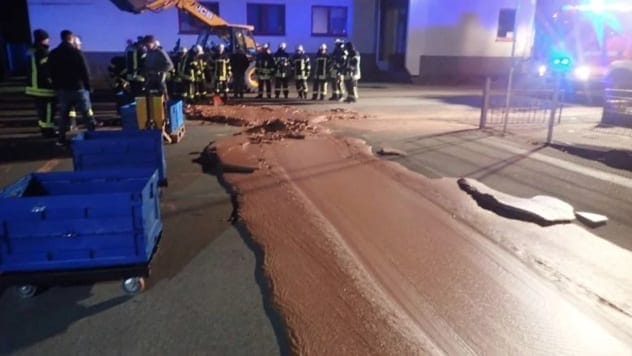
Streets literally paved with chocolate sound like a whimsical scene from a children’s storybook. However, for the residents of the small German town of Westonnen, this became a delicious, albeit problematic, reality in December 2018.
In an incident reminiscent of Willy Wonka & the Chocolate Factory, a storage tank at the DreiMeister chocolate factory overflowed. A remarkable one metric ton of molten chocolate gushed out, flowing like a river down the street. Due to the brisk winter air, the chocolate quickly solidified, creating a thick, sweet pavement. Local chocolate enthusiasts were, understandably, kept at a distance while cleanup crews embarked on the unusual task of clearing the delicious hazard. Roads were closed for several hours as workers, armed with shovels and even blowtorches, chipped away at the solidified chocolate. The manufacturer quickly reassured worried customers that this sweet spill wouldn’t impact the availability of their chocolate for Christmas.
1 Gunnedah Pet Food Explosion
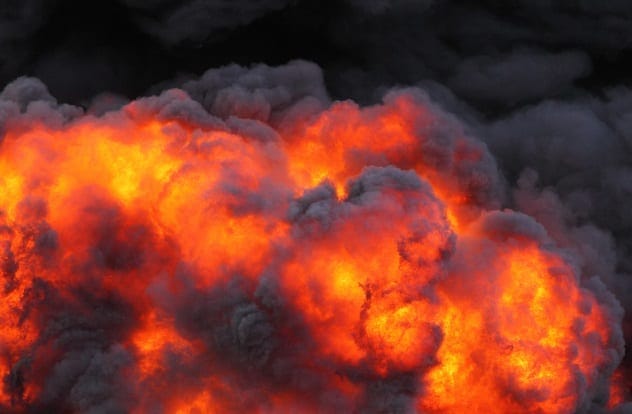
A series of terrifying explosions at an Australian pet food manufacturing plant in 2003 resulted in damage exceeding AUD $10 million. Residents in the rural town of Gunnedah were jolted awake late one night, many believing an earthquake was striking, as the powerful blasts shook their homes.
The primary explosion originated from a boiler at the nearby pet food plant and was reportedly felt up to 20 kilometers (12 miles) away. The concussive force damaged more than 30 homes and ten other buildings in the factory’s vicinity. Windows were shattered by the blast, and flying debris caused further destruction, leading one observer to describe the scene as looking like “a war zone.” Residents reported seeing a mushroom cloud form over the plant as wheat dust, a key ingredient in pet food production, ignited. The situation was compounded as LPG gas cylinders within the plant continued to catch fire, causing a series of ongoing explosions throughout the night. Emergency crews worked tirelessly to evacuate residents and bring the volatile situation under control. Miraculously, there were no casualties in the explosions, although the factory building itself was quickly reduced to a twisted wreck of metal girders.
Who knew that beer, molasses, chocolate, and even cheese could cause such widespread destruction? These ten stories serve as a startling reminder that even the most ordinary items can have extraordinary—and sometimes dangerous—consequences under the wrong circumstances. It certainly gives you a new perspective on what’s in your pantry!
Which of these food catastrophes surprised you the most? Do you know of any other bizarre food-related disasters? Leave your comment below and share your thoughts!










